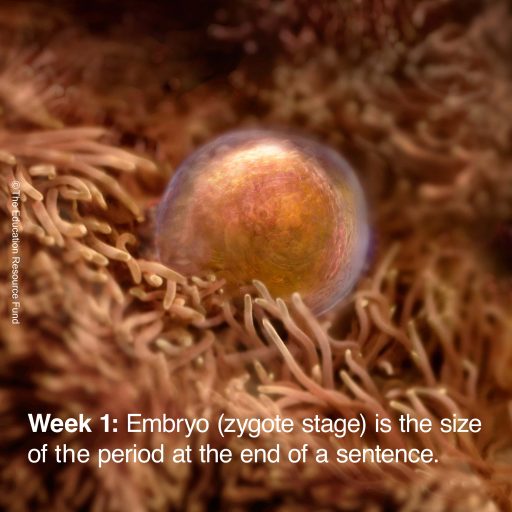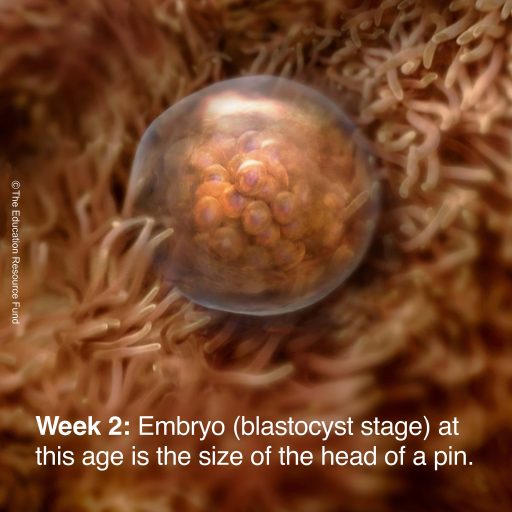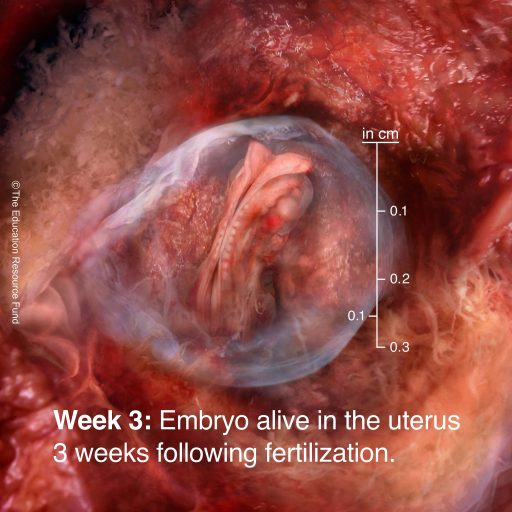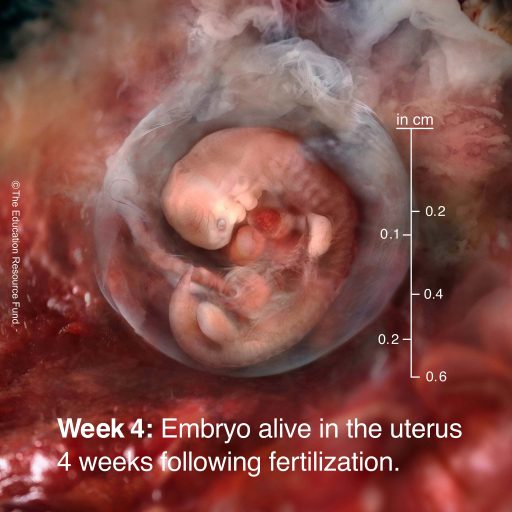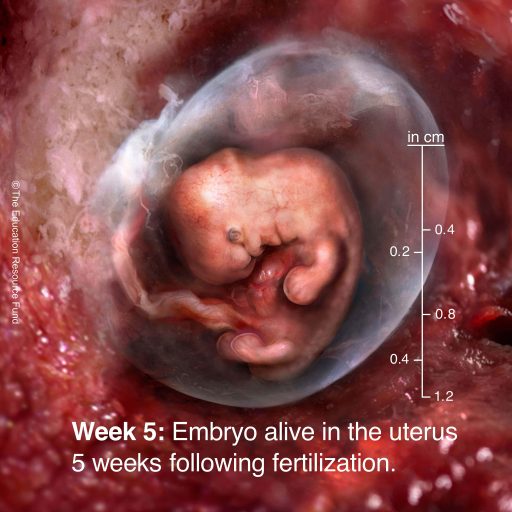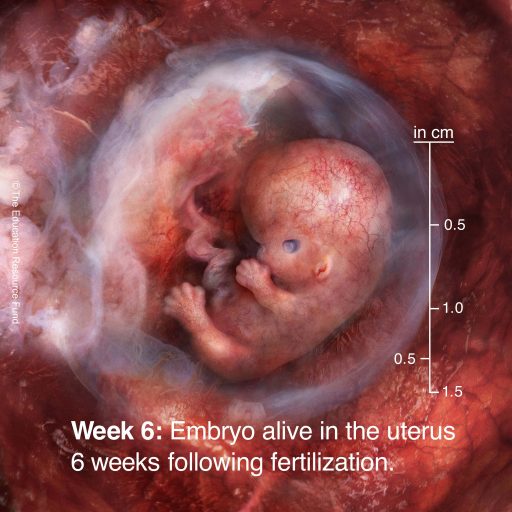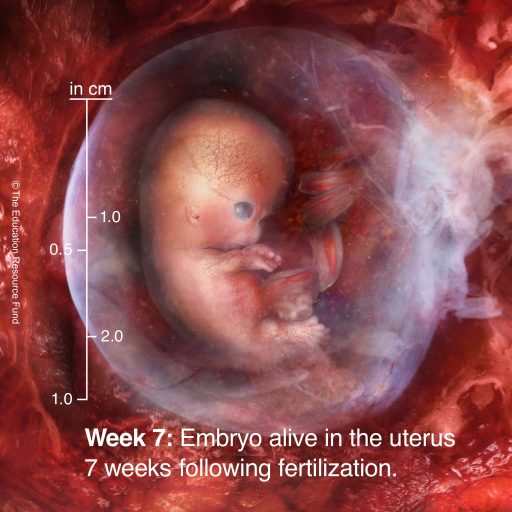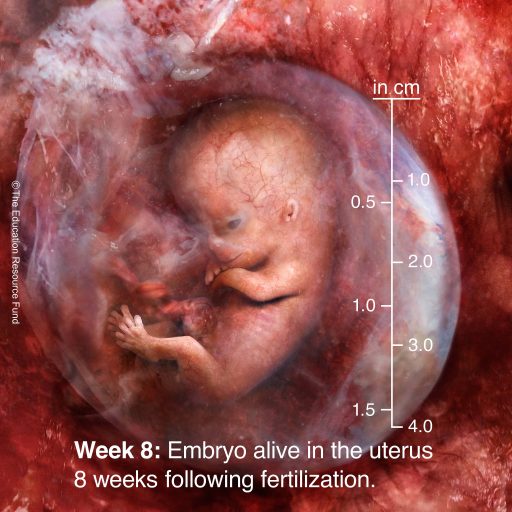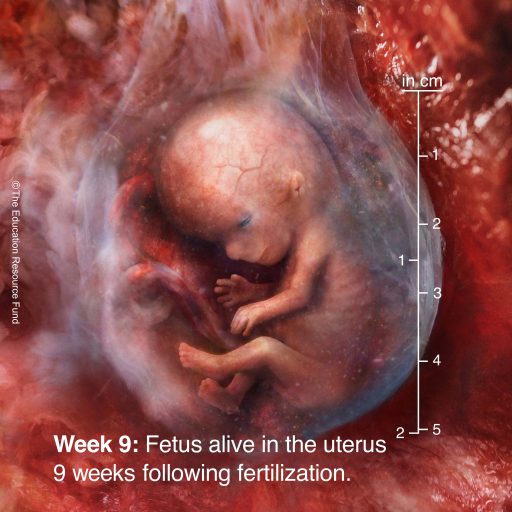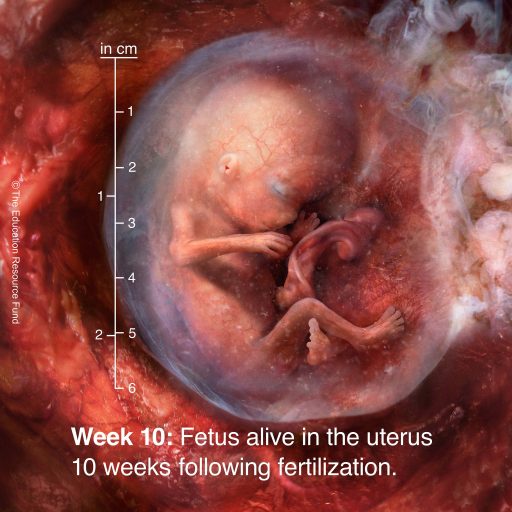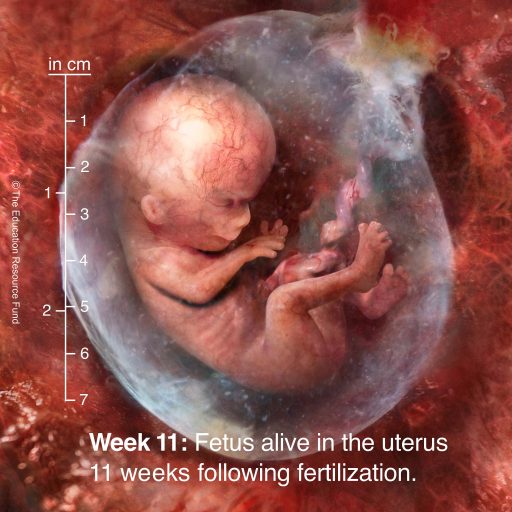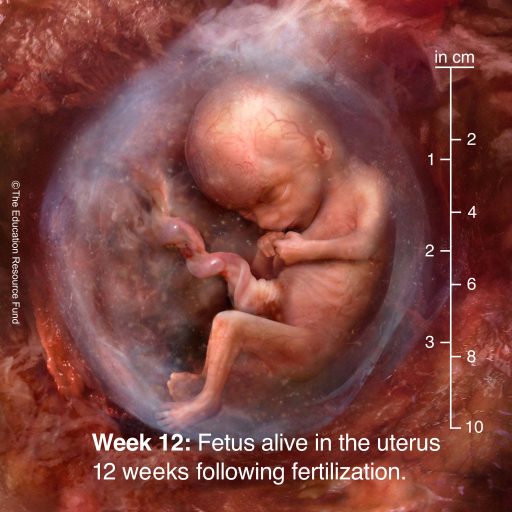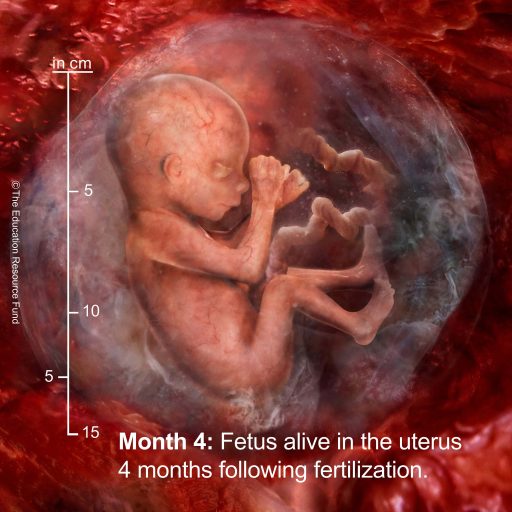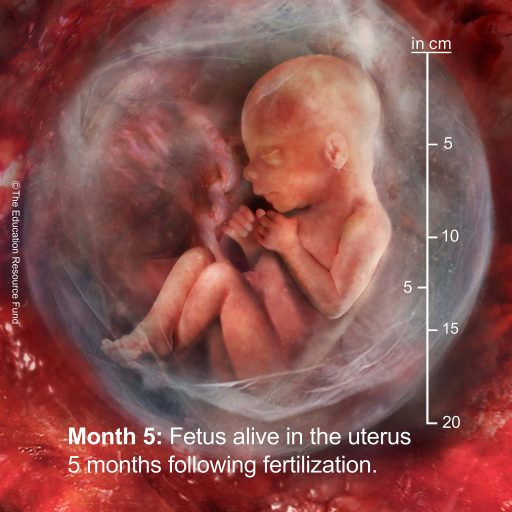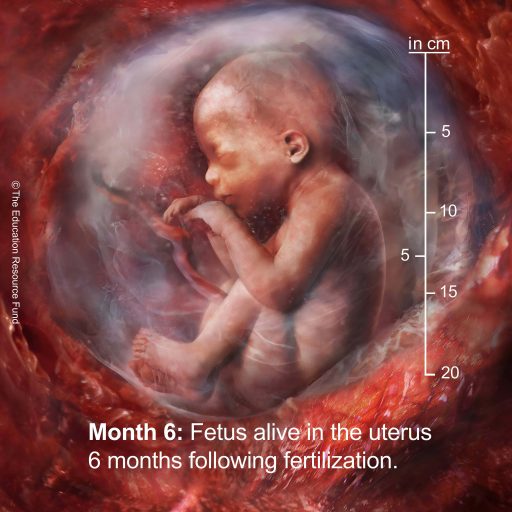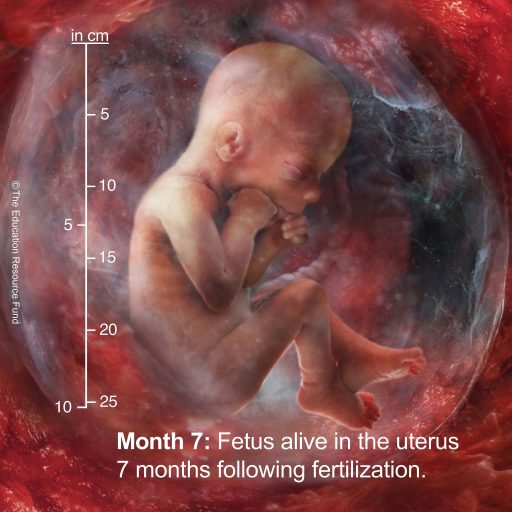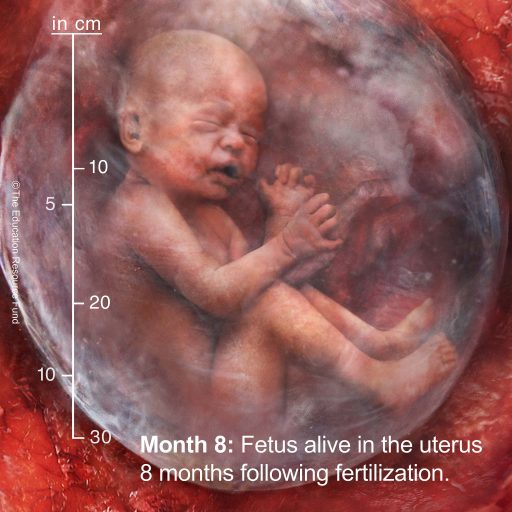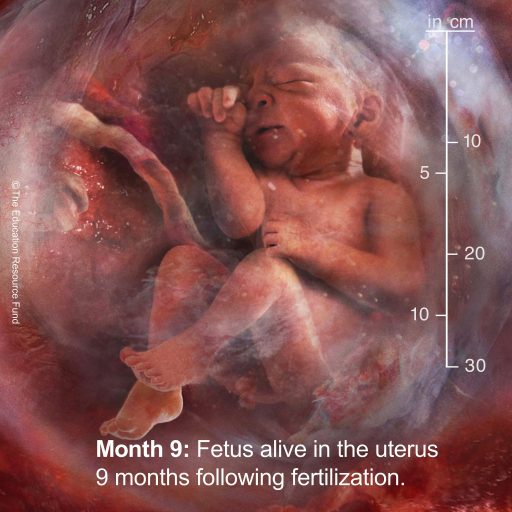Week 1:
For the first 24 hours following fertilization, the human embryo is called a zygote, and its “body” consists of just one cell.1 That cell contains 46 chromosomes which are the genetic masterplan for the entire body.2
The tightly coiled DNA molecules in that single cell contain 3 billion base pairs of digitally coded data.3 That single-cell embryo will become a 100 trillion cell adult.4
- Gasser RF. 1975. Atlas of human embryos. Maryland: Harper & Row. 1; O’Rahilly R, Müller F. 2001. Human embryology and teratology. 3rd ed. New York: Wiley-Liss. 33.
- Guyton AC, Hall JE. 2000. Textbook of medical physiology. 10th ed. Philadelphia: W.B. Saunders. 34.
- Lodish H, Berk A, Zipursky SL, Matsudaira P, Baltimore D, Darnell J. 2000. Molecular cell biology. 4th ed. New York: W.H. Freeman.
- Guyton AC, Hall JE. 2000. Textbook of medical physiology. 10th ed. Philadelphia: W.B. Saunders. 2; Lodish H, Berk A, Zipursky SL, Matsudaira P, Baltimore D, Darnell J. 2000. Molecular cell biology. 4th ed. New York: W.H. Freeman. 12.
Week 2:
Cardiac development is initiated at the end of the second week, when cardiomyocyte cells become electrically competent and begin to randomly twitch.5
About two weeks following fertilization, the neural plate begins to fold over itself, eventually forming a tube-shaped structure which will become the brain and spinal cord.6
- Buijtendijk MFJ, Barnett P, van den Hoff MJB. 2020. Development of the human heart. American Journal of Medical Genetics Part C: Seminars in Medical Genetics. 184(1):7-22.
- Urban Child Institute. Baby’s brain begins now: Conception to age 3.
Week 3:
The tubular heart begins to beat at 22 to 23 days.7 An ECG (electrocardiogram) resembling that produced by an adult heart can already be registered.8
A flow of calcium ions into and out of the cardiomyocytes (heart muscle fibers) triggers the first heart beats.9 The developed heart will pump 2,000 gallons of blood per day. In a 70-year lifetime, an average human heart beats more than 2.5 billion times.10
- Moore KL, Persaud TVN, Torchia MG. 2016. The developing human: Clinically oriented embryology. 10th ed. Philadelphia: Elsevier. 62.
- Buijtendijk MFJ, Barnett P, van den Hoff MJB. 2020. Development of the human heart. American Journal of Medical Genetics Part C: Seminars in Medical Genetics. 184(1):7-22.
- Rapila R, Korhonen T, Tavi P. 2008. Excitation-contraction coupling of the mouse embryonic cardiomyocyte. J Gen Physiol. 132(4):397-405.
- American Heart Association. Heart facts infographic. Every 72 hours the heart pumps enough blood to fill a typical tank truck (Harmon N. 2023. How much does a tank trailer hold? Trailers of Texas).
Week 4:
Cardiovascular circulation is initially an ebb and flow process, but by the end of the 4th week, coordinated contractions of the heart produce a unidirectional blood flow.11
Three brain vesicles (forebrain, midbrain, and hindbrain) have formed by the 4th week.12
- Moore KL, Persaud TVN, Torchia MG. 2016. The developing human: Clinically oriented embryology. 10th ed. Philadelphia: Elsevier. 291.
- Moore KL, Persaud TVN, Torchia MG. 2016. The developing human: Clinically oriented embryology. 10th ed. Philadelphia: Elsevier. 392; Bartelmez GW. 1923. The subdivisions of the neural folds in man. J Comp Neurol. 35(3):231-247. 236; Müller F, O’Rahilly R. 1983. The first appearance of the major divisions of the human brain at stage 9. Anat Embryol. 168(3):419-432. 419-420,429; O’Rahilly R, Gardner E. 1979. The initial development of the human brain. Acta Anat. 104(2):123-133. 123,129; O’Rahilly R, Müller F. 1984. Chevalier Jackson lecture. Respiratory and alimentary relations in staged human embryos. New embryological data and congenital anomalies. Ann Otol Rhinol Laryngol. 93(5 Pt 1):421-429. 422; O’Rahilly R, Müller F. 1987. Developmental stages in human embryos. Washington: Carnegie Institution. 90; O’Rahilly R, Müller F. 1999. The embryonic human brain: An atlas of developmental stages. 2nd ed. New York: Wiley-Liss. 47,52.
Week 5:
By the 5th week, the brain has divided into 5 secondary vesicles.13 Neuroblasts, or immature brain cells, are forming, and will develop into neurons.14
Early reproductive cells, which will become sperm and oocytes (eggs), are migrating to the reproductive organs.15
- O’Rahilly R, Müller F. 1999. The embryonic human brain: An atlas of developmental stages. 2nd ed. New York: Wiley-Liss. 134; Sadler TW. 2005. Langman’s essential embryology. Philadelphia: Lippincott Williams & Wilkins. 106.
- Moore KL, Persaud TVN, Torchia MG. 2016. The developing human: Clinically oriented embryology. 10th ed. Philadelphia: Elsevier. 395.
- O’Rahilly R, Müller F. 2001. Human embryology and teratology. 3rd ed. New York: Wiley-Liss. 23; Waters BL, Trainer TD. 1996. Development of the human fetal testis. Pediatr Pathol Lab Med. 16(1):9-23. 16; Witschi E. 1948. Migration of the germ cells of human embryos from the yolk sac to the primitive gonadal folds. Carnegie Institution of Washington. Publ. 575. Contrib Embryol. 32:67-80. 70,77,79.
Week 6:
Brain waves have been recorded as early as 6 weeks.16
The embryo begins to make spontaneous and reflexive movements,17 and hand motions can be observed.18
- Borkowski WJ, Bernstine RL. 1955. Electroencephalography of the fetus. Neurology. 5(5):362-365. 363 (cited by Bernstine RL. 1961. Fetal electrocardiography and electroencephalography. Springfield: Charles C. Thomas. 63,66; O’Rahilly R, Müller F. 1999. The embryonic human brain: an atlas of developmental stages. 2nd ed. New York: Wiley-Liss. 195; van Dongen LGR, Goudie EG. 1980. Fetal movement patterns in the first trimester of pregnancy. Br J Obstet Gynaecol. 87(3):191-193. 193); Hamlin H. 1964. Life or death by EEG. Journal of the American Medical Association. 90(2):112-114. 113. For a summary of in utero fetal encephalography (measuring brainwaves) in the near-term fetus using abdominal and vaginal electrodes see Bernstine RL, Borkowski WJ, Price AH. 1955. Prenatal fetal electroencephalography. Am J Obstet Gynecol. 70(3):623-630.
- Birnholz JC, Stephens JC, Faria M. 1978. Fetal movement patterns: A possible means of defining neurologic developmental milestones in utero. Am J Roentgenol. 130(3):537-540. 539; de Vries JIP, Visser GHA, Prechtl HFR. 1982. The emergence of fetal behaviour. I. Qualitative aspects. Early Hum Dev. 7(4):301-322. 301,304: “The first movements were observed at 7.5 weeks postmenstrual age.” [or 5½ weeks postfertilization age]; Humphrey T. 1964. Growth and maturation of the brain – some correlations between the appearance of human fetal reflexes and the development of the nervous system. In: Dominick P, Purpura DP, Schadé JP, editors. Progress in brain research. Vol 4. Amsterdam: Elsevier. 93-135. 99: earliest reflex 5½ weeks; Humphrey T. 1970. The development of human fetal activity and its relation to postnatal behavior. Advances in child development and behavior. Vol 5. Reese HW, Lipsitt LP, editors. New York: Academic. 12; Humphrey T, Hooker D. 1959. Double simultaneous stimulation of human fetuses and the anatomical patterns underlying the reflexes elicited. J Comp Neurol. 112:75-102. 76; Humphrey T, Hooker D. 1961. Reflexes elicited by stimulating perineal and adjacent areas of human fetuses. Trans Am Neurol Assoc. 86:147-152. 147; Kurjak A, Chervenak FA, editors. 1994. The fetus as a patient. New York: Parthenon. 48; Visser GH, Mulder EJ, Prechtl HF. 1992. Studies on developmental neurology in the human fetus. Dev Pharmacol Ther. 18(3-4):175-183. 175-176: “Endogenously generated fetal movements can first be observed after 7 weeks postmenstrual age (i.e. 5 weeks after conception)”; O’Rahilly R, Müller F. 1999. The embryonic human brain: an atlas of developmental stages. 2nd ed. New York: Wiley-Liss. 336: 5½ weeks postfertilization; Sorokin Y, Dierker LJ. 1982. Fetal movement. Clin Obstet Gynecol. 25(4):719-734. 723,726; Natsuyama E. 1991. In utero behavior of human embryos at the spinal-cord stage of development. Biol Neonate. 60(Suppl 1):11-29. 13: spontaneous movement observed by “Carnegie stage 15” (about 33 days postfertilization); Hogg ID. 1941. Sensory nerves and associated structures in the skin of human fetuses of 8 to 14 weeks of menstrual age correlated with functional capability. J Comp Neur. 75:371-410. 373: reflex activity begins at 6½ weeks [adjusted to postfertilization age].
- Endoscopic scans in “The Science of Life Before Birth,” Education Resource Fund, 2023.
Week 7:
The initial developmental stages of the vital external and internal body structures emerge between the 4th and 8th weeks.19
Ovaries are identifiable by the 7th week.20
- Moore KL, Persaud TVN, Torchia MG. 2016. The developing human: Clinically oriented embryology. 10th ed. Philadelphia: Elsevier. 88.
- O’Rahilly R, Müller F. 2001. Human embryology and teratology. 3rd ed. New York: Wiley-Liss. 320.
Week 8:
From the 5th week on, a vast number of brain cells proliferate in the ventricular zone, which contains a highly detailed protomap of the regions of the brain to which each cell will migrate.21
Each cell contains a specific “map address” which directs its travel to its final location in the brain. Brain cells of the same type recognize one another and gravitate toward each other, often positioning themselves in the same orientation as neighboring cells.22
- Ackerman S. 1992. Discovering the brain. 6, The development and shaping of the brain. Washington (DC): National Academies Press (US). National Center for Biotechnology Information. National Library of Medicine. National Institutes of Health.
- Ackerman S. 1992. Discovering the brain. 6, The development and shaping of the brain. Washington (DC): National Academies Press (US). National Center for Biotechnology Information. National Library of Medicine. National Institutes of Health.
Week 9:
Since week 8, the human embryo has possessed more than 90% of the structures found in the adult body.23
The uterus is identifiable24 and immature reproductive cells are replicating in the ovaries.25 They will eventually become oocytes, or “eggs.”
- O’Rahilly R, Müller F. 2001. Human embryology and teratology. 3rd ed. New York: Wiley-Liss. 87: “It has been estimated that more than 90% of the more than 4500 named structures of the adult body become apparent during the embryonic period (O’Rahilly).”
- O’Rahilly R. 1977. The development of the vagina in the human. Birth Defects Orig Artic Ser. 13(2):123-136. 128; O’Rahilly R. 1977. Prenatal human development. In: Wynn RM, editor. The biology of the uterus. 2nd ed. New York: Plenum. 53; O’Rahilly R, Müller F. 2001. Human embryology and teratology. 3rd ed. New York: Wiley-Liss. 327.
- O’Rahilly R, Müller F. 2001. Human embryology and teratology. 3rd ed. New York: Wiley-Liss. 25,322.
Week 10:
Ossification (tissue such as cartilage being replaced by bone) is underway in most skeletal structures.26
The fetus now yawns and opens and closes its mouth.27
- Cunningham FG, Gant NF, Leveno KJ, Gilstrap LC, Hauth JC, Wenstrom KD, editors. 2001. Williams Obstetrics. 21st ed. New York: McGraw-Hill. 133.
- de Vries JIP, Visser GHA, Prechtl HFR. 1982. The emergence of fetal behaviour. I. Qualitative aspects. Early Hum Dev. 7(4):301-322. 309.
Week 11:
Throughout embryonic and fetal development, the cells of the growing body receive electrochemical signals from their environment, and communicate with neighboring cells.28
Taste buds now cover the inside of the mouth, but only those on the tongue and roof of the mouth will remain by birth.29
- Moore KL, Persaud TVN, Torchia MG. 2016. The developing human: Clinically oriented embryology. 10th ed. Philadelphia: Elsevier. 488.
- Lecanuet JP, Schaal B. 1996. Fetal sensory competencies. Eur J Obstet Gynecol Reprod Biol. 68(1-2):1-23. 3; Miller AJ. 1982. Deglutition. Physiol Rev. 62(1):129-181. 169; Mistretta CM, Bradley RM. 1975. Taste and swallowing in utero. Br Med Bull. 31(1):80-84. 80.
Week 12:
The brain of a 12-week fetus develops 250,000 new neurons per minute.30 That’s 15 million per hour.
The brain of a 9-month fetus will have 100 billion neurons, the approximate number of stars in the Milky Way Galaxy.31 Those neurons will be interconnected by 100 trillion synapses.32
- Ackerman S. 1992. Discovering the brain. 6, The development and shaping of the brain. Washington (DC): National Academies Press (US). National Center for Biotechnology Information. National Library of Medicine. National Institutes of Health.
- The University of Maine. Cooperative Extension Publications. Bulletin #4356, Children and brain development: What we know about how children learn.
- Ackerman S. 1992. Discovering the brain. 6, The development and shaping of the brain. Washington (DC): National Academies Press (US). National Center for Biotechnology Information. National Library of Medicine. National Institutes of Health.
Month 4:
Small intestines will take in nutrients and pass them into the blood stream for transport to the liver. The liver then converts them into usable substances to store and distribute where and when needed.33 The liver also filters toxins34 and manages blood sugar.35
The liver identifies, captures, and destroys pathogens with massive numbers of patrolling phagocytes which it deploys to ingest invading viruses, bacteria, etc.36
- webmd.com/digestive-disorders/ss/slideshow-liver-overview. Nutrient center.
- webmd.com/digestive-disorders/ss/slideshow-liver-overview. Detox central.
- webmd.com/digestive-disorders/ss/slideshow-liver-overview. Fuel tank.
- webmd.com/digestive-disorders/ss/slideshow-liver-overview. Security gate.
Month 5:
There will be 300-500 million alveolar sacs in the lungs, exchanging oxygen for carbon dioxide waste gas.37 This gas exchange is made possible by the design of the alveoli and capillaries, whose walls are only one cell thick.38
The lungs will perform approximately 20,000 inhalation-exhalation cycles per day, or 400 million by age 50.39
- Biology Dictionary. biologydictionary.net/respiratory-system-fun-facts. Numbered paragraph 5.
- Biology Dictionary. biologydictionary.net/respiratory-system-fun-facts. Numbered paragraph 8.
- webmd.com/lung/ss/slideshow-lung-facts-overview.
Month 6:
Kidneys will cleanse the blood of toxins, keep it chemically balanced, regulate blood pressure, and secrete essential hormones.40
The kidneys will also filter 200 liters (52.8 gallons) of fluid every 24 hours, return vitamins, amino acids, and glucose to the blood stream, and maintain the body’s water content at a constant level.41
- Kidney Research UK. The kidneys – a basic guide.
- Kidney Research UK. The kidneys – a basic guide.
Month 7:
The small intestines will account for most digestive activity, but the stomach also processes food, producing digestive fluid in the form of hydrochloric acid, from which it must shield its lining by producing a new protective coating every two weeks.42
The body will generate one half-gallon of hydrochloric acid and two pints of saliva each day.43 Neurons lining the stomach and intestines operate independently to also digest food, leading to their characterization as the body’s second brain.44
- Biology Dictionary. biologydictionary.net/digestive-system-fun-facts. Numbered paragraphs 1,4.
- Biology Dictionary. biologydictionary.net/digestive-system-fun-facts. Numbered paragraphs 4,14.
- Cleveland Clinic. The gut-brain connection. Enteric nervous system.
Month 8:
The brain is the most complex entity in the known universe.45 It will store 2,500,000 gigabytes of information,46 and will be capable of retaining one quadrillion (1,000 trillion) life-long memories.47
It will require only 1/10,000th of a second to register sensory input and generate responsive action,48 routing information at speeds up to 268 miles per hour.49
- LaRosa T. The most complicated object in the universe and why recognizing the complexity of the brain illuminates the conversation around researching diseases such as Alzheimer’s and epilepsy. NeuLine Health.
- Clinical Neurology Specialists. What is the memory capacity of a human brain?
- Winston Medical Center. Human brain facts.
- The Healthy. 28 amazing facts about your brain ….
- Ross V. 2019. Numbers: The nervous system, from 268-MPH signals to trillions of synapses. Discover Magazine.
Month 9:
The brain will be comprised of 10,000 different types of specialized neurons (more cell types than any other organ)50 and is operated by 100,000 chemical reactions per second.51
It will require support from nearly 100,000 miles of cranial blood vessels which will provide detox functions, oxygenation, and nutrition.52 The brain takes longer than any other organ to fully develop.53
- Saplakoglu Y. 2023. New cell atlases reveal untold variety in the brain and beyond. Quanta Magazine; Anythink. Exploring the human brain; The Healthy. 28 amazing facts about your brain ….
- Exploring the human brain.
- Penn Medicine News. Using data to map the human brain.
- First Things First. The first five years.


